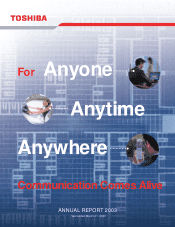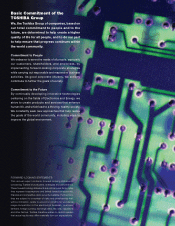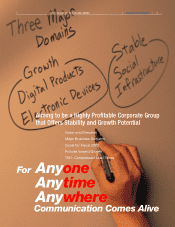Toshiba 2002 Annual Report Download - page 5
Download and view the complete annual report
Please find page 5 of the 2002 Toshiba annual report below. You can navigate through the pages in the report by either clicking on the pages listed below, or by using the keyword search tool below to find specific information within the annual report.
3
TOSHIBA CORPORATION
TO OUR SHAREHOLDERS
An Overview of Fiscal 2002
Industry Environment
Fiscal 2002, to March 31, 2003, opened on a positive note,
as the world’s markets saw encouraging signs of recovery in
the United States, and inventory adjustments contributed to
an upturn in production. However, hopes for a moderate
but sustainable global recovery proved short-lived. Overseas,
geopolitical instability provoked doubt and a change of
mood. In the U.S., the stock market declined as petroleum
prices edged up, and individual consumption stagnated as
concerns for property values undermined consumer confi-
dence. In Europe, markets once again became sluggish. The
only bright spots and expanding markets were to be found
in China and other Asian countries that have become the
workshops of the world. But the appearance of Severe Acute
Respiratory Syndrome (SARS) in those countries raises ques-
tions about the economic impact of the illness, and how
affected regions can maintain high growth. While Japan ex-
perienced substantial growth, due to the economic
conditions in other Asian countries and a focus on recovery
in export-led industries, domestic deflation combined with a
long-term slump in private-sector capital investment and
public spending to produce a negative nominal growth rate.
Japan continues to experience severe setbacks in its transi-
tion to recovery.
Progress of the 01 Action Plan
Even in the midst of these severe economic conditions, we de-
clared fiscal 2002 to be “The First Year of Toshiba’s
Regeneration” and took decisive steps to strengthen competi-
tiveness. Chief amongst these steps was accelerated execution
of our 01 Action Plan—a three-year initiative announced in
fiscal 2001—to bring forward the positive results we targeted.
The Plan has supported us in raising management efficiency
across the Group, promoting asset-light management and de-
veloping a clear focus on selected businesses. Achievements of
the 01 Action Plan include a 20% reduction in procurement
over two years, a Group-wide reduction of human resources by
10%, and ¥800 billion asset cuts.
Drawing on Toshiba Value Created (TVC), a methodology
we created for evaluating business performance, we initiated a
series of restructuring measures in fiscal 2002. Among these
were a joint venture with Matsushita Electric Industrial Co.,
Ltd. in color cathode ray tubes, and the merger of our indus-
trial electric and automation systems businesses with that of
Mitsubishi Electric Corporation. Continued competitiveness
in the semiconductor industry was bolstered by the decision
to initiate a four-year, ¥350 billion investment program to
construct advanced fabrication facilities that will put 300
millimeter wafer lines at the center of Toshiba’s production of
memory devices and system LSIs. In a move made to en-
hance the brand value of our digital products businesses,
Toshiba acquired Amuse Pictures, Inc., one of Japan’s leading
independent film producers and distributors.
As we worked for our ambitious goal of cutting procurement
costs by 20% over two years, we also saw progress in Group-
wide integration of procurement and in bringing engineers
into procurement activities. These and other measures, in-
cluding a greater emphasis on e-procurement, are expected to
promote cost reductions in all aspects of our activities and
add to the competitiveness of Toshiba products.
Our efforts to reduce human resources were rewarded when
we met our headcount target in fiscal 2002, a year earlier
than planned. We were also successful in efforts to reduce as-
sets by ¥450 billion, in addition to the ¥350 billion originally
planned.
Achievements in Fiscal 2002
Consolidated Group sales in fiscal 2002 were ¥5,655.8 bil-
lion, a 5% increase compared to fiscal 2001. Operating
income amounted to ¥115.5 billion, an increase of ¥229.1
billion over fiscal 2001. Income before taxes totaled ¥53.1
billion, an increase of ¥429.8 billion against fiscal 2001.
These results took us a steady step forward toward recovery,
and allowed us to pay a three-yen full-term dividend.
Mid-term Business Plan
This year marks the launch of our latest mid-term business
plan, which builds on our achievements in fiscal 2002 and
represents our expectations for the years after fiscal 2003.
We are at the threshold of a new age, an age of ubiquitous
computing. In coming years, immense processing capabilities
and powerful broadband networks will support the creation
Tadashi
Okamura
Director,
President and
Chief Executive Officer
TO OUR SHAREHOLDERS
アニレポp1-26( 英) 6 .18 03 .6.25, 8 :05 PMPage 3 Adobe PageMaker 7 .0J / PPC


















